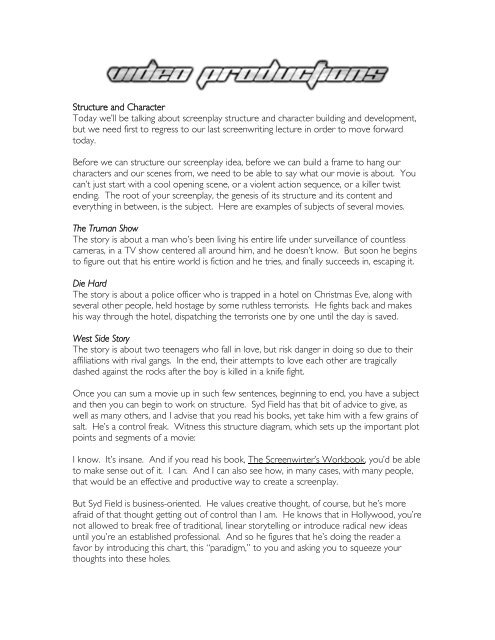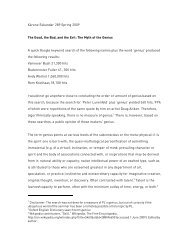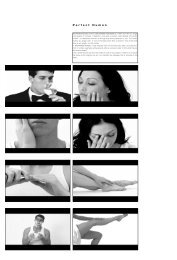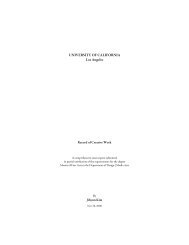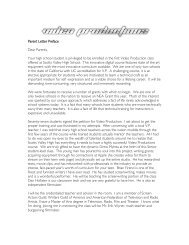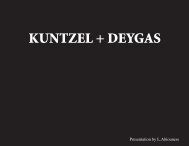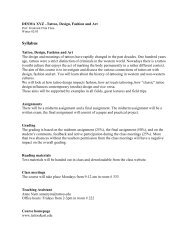Structure and Character Today we'll be talking about ... - Users
Structure and Character Today we'll be talking about ... - Users
Structure and Character Today we'll be talking about ... - Users
You also want an ePaper? Increase the reach of your titles
YUMPU automatically turns print PDFs into web optimized ePapers that Google loves.
<strong>Structure</strong> <strong>and</strong> <strong>Character</strong><strong>Today</strong> we’ll <strong>be</strong> <strong>talking</strong> <strong>about</strong> screenplay structure <strong>and</strong> character building <strong>and</strong> development,but we need first to regress to our last screenwriting lecture in order to move forwardtoday.Before we can structure our screenplay idea, <strong>be</strong>fore we can build a frame to hang ourcharacters <strong>and</strong> our scenes from, we need to <strong>be</strong> able to say what our movie is <strong>about</strong>. Youcan’t just start with a cool opening scene, or a violent action sequence, or a killer twistending. The root of your screenplay, the genesis of its structure <strong>and</strong> its content <strong>and</strong>everything in <strong>be</strong>tween, is the subject. Here are examples of subjects of several movies.The Truman ShowThe story is <strong>about</strong> a man who’s <strong>be</strong>en living his entire life under surveillance of countlesscameras, in a TV show centered all around him, <strong>and</strong> he doesn’t know. But soon he <strong>be</strong>ginsto figure out that his entire world is fiction <strong>and</strong> he tries, <strong>and</strong> finally succeeds in, escaping it.Die HardThe story is <strong>about</strong> a police officer who is trapped in a hotel on Christmas Eve, along withseveral other people, held hostage by some ruthless terrorists. He fights back <strong>and</strong> makeshis way through the hotel, dispatching the terrorists one by one until the day is saved.West Side StoryThe story is <strong>about</strong> two teenagers who fall in love, but risk danger in doing so due to theiraffiliations with rival gangs. In the end, their attempts to love each other are tragicallydashed against the rocks after the boy is killed in a knife fight.Once you can sum a movie up in such few sentences, <strong>be</strong>ginning to end, you have a subject<strong>and</strong> then you can <strong>be</strong>gin to work on structure. Syd Field has that bit of advice to give, aswell as many others, <strong>and</strong> I advise that you read his books, yet take him with a few grains ofsalt. He’s a control freak. Witness this structure diagram, which sets up the important plotpoints <strong>and</strong> segments of a movie:I know. It’s insane. And if you read his book, The Screenwirter’s Workbook, you’d <strong>be</strong> ableto make sense out of it. I can. And I can also see how, in many cases, with many people,that would <strong>be</strong> an effective <strong>and</strong> productive way to create a screenplay.But Syd Field is business-oriented. He values creative thought, of course, but he’s moreafraid of that thought getting out of control than I am. He knows that in Hollywood, you’renot allowed to break free of traditional, linear storytelling or introduce radical new ideasuntil you’re an established professional. And so he figures that he’s doing the reader afavor by introducing this chart, this “paradigm,” to you <strong>and</strong> asking you to squeeze yourthoughts into these holes.
I say come what may. You can use this structure if you like, but going with your gut feelingis sometimes <strong>be</strong>tter than going with Syd Field’s gut feeling. If the square block isn’t fitting inthe circle hole, may<strong>be</strong> it’s the hole you need to get rid of <strong>and</strong> not the square.Knowhutimean? In this class, I’m encouraging a bit more creative freedom <strong>and</strong> I’m allowingyou to let your creative pistons fire a bit more to tell the story you want to tell—<strong>be</strong>causeGod knows you won’t <strong>be</strong> able to when you’re punching out a second draft of someoneelse’s TV sitcom script <strong>and</strong> you’ve got a focus group breathing down your neck. Besides,for many of you this is your first full-length script, so what the heck? Ramble a little.But in no way am I saying you can just toss out a stream-of-consciousness hunk of treebark. I don’t want to sound hypocritical <strong>and</strong> contradict what I just said, but I <strong>be</strong>lieve thatstructure, in its theory <strong>and</strong> rigidity, is actually extremely necessary. That’s why we’ll <strong>be</strong>taking the most basic elements of Mr. Field’s paradigm <strong>and</strong> applying them to our work.Here is the simplified version, which I think can <strong>be</strong> really conducive to writing <strong>and</strong> editingyour script.This, I think, will work much <strong>be</strong>tter. Most likely, your scripts will work in a three-actstructure, <strong>and</strong> your plot points near the ends of acts I <strong>and</strong> II will throw the plot into thenext stage of its trip to the end, or conclusion. The rest of that pretty ornamentation wasto help guide you in writing Act II, which Field <strong>be</strong>lieves is the most difficult act for youngwriters to maneuver through. Here’s why:In Act I , the writer must establish the players <strong>and</strong> the conflict; he/she must “set-up” theaction which will carry on into Act II. The writer is required to create drama <strong>and</strong> “lay outscenes <strong>and</strong> sequences that build <strong>and</strong> exp<strong>and</strong> the information of your story.” Somewherearound the end of Act I (which will go on for however long you need it to), Plot Point 1must appear. We’ll go over plot points after the acts. This sounds like a lot to do, but thefact that Act I assigns you so many important tasks is good, <strong>be</strong>cause you’re forced to think,from the start, how your story will work.Act III is concerned with resolving the conflicts, problems, dilemmas, <strong>and</strong> desires of thecharacters, wrapping everything up <strong>and</strong> putting a nice pink bow on top. You’ve got toknow how your story ends, <strong>be</strong>cause “if you don’t, who will?”Those acts are simple enough to write. As long as you’ve got your subject down, youshould <strong>be</strong> able to construct something that at least resembles a set-up <strong>and</strong> a resolution.Besides, when you think back to movies, what do you remem<strong>be</strong>r the most? How they<strong>be</strong>gan <strong>and</strong> how they ended, right?Act II is how the <strong>be</strong>ginning gets to the ending. It’s responsible for taking you there in aplausible fashion, while keeping things entertaining. In several movie-watching instanceswhere you feel the blood start to drain from your legs <strong>and</strong> your posterior getting weak,you can probably blame Act II. It’s the longest <strong>and</strong> least memorable of the three acts, butit’s got to shoulder the conflict <strong>and</strong> keep things interesting until the story winds its waydown in Act III. This is definitely a difficult act to write, but I think that Plot Pint 2 workswell as the hinge on which Act II rests. If you can take the conflict of the plot that Plot
Point 1 created, <strong>and</strong> run with that conflict by showing how the characters are affected by it<strong>and</strong> what they do, all the way to Plot Point 2, then you should <strong>be</strong> fne.Plot Points “move the story forward,” <strong>and</strong> they don’t just come up in pairs with movies.There can <strong>be</strong> many, many plot points, which twist, turn, propel, <strong>and</strong> detour the storythroughout, but Plot Point 1 <strong>and</strong> 2 are the big guns when it comes to keeping theaudience’s interest. Plot Point 1 is the moment, <strong>be</strong> it a revelation, a gun shot, a phone call,or whatever, that finally sets up the conflict that leads into Act II, the meat of the story.Plot Point II raises the stakes (perhaps another gunshot, if your name is John Woo). This2 nd plot point “spins the action into a new direction,” which hopefully has the moviegoergripping their armrest a bit tighter or at least watching more intently when the whole trainfinally comes to a stop in Act III.This structure is basic, but I require that it <strong>be</strong> not just taken into consideration when writingyour scripts, but employed to the <strong>be</strong>st of your abilities. You need to <strong>be</strong> able to show thatyou can write film scripts the way Hollywood wants you to. Besides, that’s probably theway you want to write them, too. You just like complaining too much to notice it.<strong>Character</strong>sUsing an ever-so-clever analogy in my last lecture, I stated that the plot of the movie is therollercoaster, <strong>and</strong> the characters are the people who ride in it with you. I coupled thatanalogy with the theory of the film <strong>be</strong>ing this fantastic, unordinary journey, <strong>and</strong> thecharacters were the people who took that journey. You, as an audience mem<strong>be</strong>r, want toidentify with these characters so that you can feel like you’re on that journey. Thus, thesecharacters have to <strong>be</strong> developed to the extent that we care <strong>about</strong> them. Then, they’resitting right next to us in that cab as we speed right along the rollercoaster.Syd Field doesn’t disagree, from what I’ve read. But he likes to say that “Action is<strong>Character</strong>—what a person does is what he is, not what he says.” By this, he is commentingon the nature of your character when he, say, is under pressure, or wants something badly.What he will do to achieve his goals <strong>and</strong> overcome his obstacles – or won’t, for thatmatter – really defines who he is.“…what makes a good character? Conflict? Definitely. Background? Definitely.Personality? Definitely. But these qualities are only parts of the whole. In order to create acharacter we must first establish a context of character; that way, we can color <strong>and</strong> shadeour various traits <strong>and</strong> mannerisms later.”And Syd Field’s context in question, since I’m ripping off of him a bunch already, consists offour areas:Dramatic Need – what your character wants, needs, absolutely has to have. Many actionthrillers simply have their main characters desire deeply to survive. How much moredramatic can you get than someone’s life <strong>be</strong>ing on the line? But other characters needmoney. Some need to <strong>be</strong> loved. Others are chasing after that dream girl/guy. “Once youestablish your character’s dramatic need you can create obstacles to that need.”
Point of View – The way that character interprets <strong>and</strong> views the world around him. Whatdoes your character think of current events, or different issues? Are they vegan? Do theyabsolutely hate people with thick lower lips? This point of view doesn’t just help dress upyour character—if their opinions are especially controversial or they firmly <strong>be</strong>lieve in them,you can create conflict just through that. Suppose your character is a Wall Streetbusinessman who absolutely treasures money, <strong>be</strong>lieves it is what makes the world goaround. Now what if the villain steals the money away? Knowing how deeply thischaracter’s love for money is helps us underst<strong>and</strong> his actions further when he fights to gethis money back.Change – You’ve heard this <strong>be</strong>fore, <strong>and</strong> it still makes sense that characters have to gothrough change by the end of the screenplay. For all the rules that Clerks breaks in termsof storytelling <strong>and</strong> structure, Dante, the main character, does indeed go through a changeby the end. If your character steps off the rollercoaster in the end without having learnedsomething, or <strong>be</strong>come a <strong>be</strong>tter person, or perhaps <strong>be</strong>ing emotionally ravaged or mentally illforever after, then that sound you hear is me yawning.Attitude—Not like point of view, which concerns opinions, attitude is a more basic view ofthe character’s personality. Happy? Sad? Depressed? Emotional? Negative? Postiive?Victoria Lynn Schmidt, author of the book 45 Master <strong>Character</strong>s, definitely delves into thetopic of character constructing deeper than Syd Field does. The path she takes is anintriguing notion…mining the archetypes of Greek mythology to categorize all the differentcharacters present in film today…but sometimes she loses focus. Here I go, <strong>be</strong>ing a bookcritic again when I have probably written 1/3 of the num<strong>be</strong>r of screenplays these otherpeople have. But what can you say <strong>about</strong> an author who seriously considers Xena,Warrior Princess as a “complex, human <strong>and</strong> interesting” character?Anyway, she brings up this notion of Archetypes, such as The Seductive Muse, the FemmeFatale, the Gladiator, the Woman’s Man, the King, the Recluse, the Artist, the Maiden, theMystic. Not to <strong>be</strong> confused with stereotypes (which are based on bias <strong>and</strong> usually notcredible or fair), archetypes allow for much more room to make a character an individualor unique. Basically, no matter what character you come up with, the Greeks have thoughtof it already.Ms. Schmidt asks that we start building our character by imagining the physicality of them.Their facial features, their hair, their age <strong>and</strong> body type. Then, through a series of questionsthat she asks, we can calculate which archetype our character resembles the most <strong>and</strong>work from there.Schmidt’s book is interesting to flip through, <strong>and</strong> there’s no question that you will find anarchetype in there that fits your script quite nicely. Syd Field’s book talks chiefly <strong>about</strong> thecharacter doing, not just saying or <strong>be</strong>ing. Their actions should speak louder than words.I say both of these writers can contribute healthily to building a good character. But I say,in addition, that you want your character to appeal to your audience, <strong>and</strong> underst<strong>and</strong>ing abit <strong>about</strong> human psychology helps. Knowing how a teenager’s sex drive works helps youwrite such characters in a script, <strong>and</strong> underst<strong>and</strong>ing the intricacies of a troubled Vietnam
vet’s mind makes for great internal drama on the screen. It helps to do a bit of research,then, to make your players familiar <strong>and</strong> inviting to an audienceAdvice Recap:<strong>Character</strong>s are defined by what they do, not what they say. Their actions speak loud enough.Your character must need something.Your character must have a point of view.Your character must have a particular attitude.Your character must go through some sort of change by the end of the script.The character must connect with the audience, so that people can get into the movie.Look to Greek archetypal characters for similarities in your own characters.Don’t compare your characters to Xena, Warrior Princess. Do to so would <strong>be</strong> selling yourselfshort.Picture what your character may look like, act, do or say in different situations.Research the psychology of people that your character resembles so that your portrayal isaccurate, insightful, <strong>and</strong> therefore can forge a connection with the audience.


